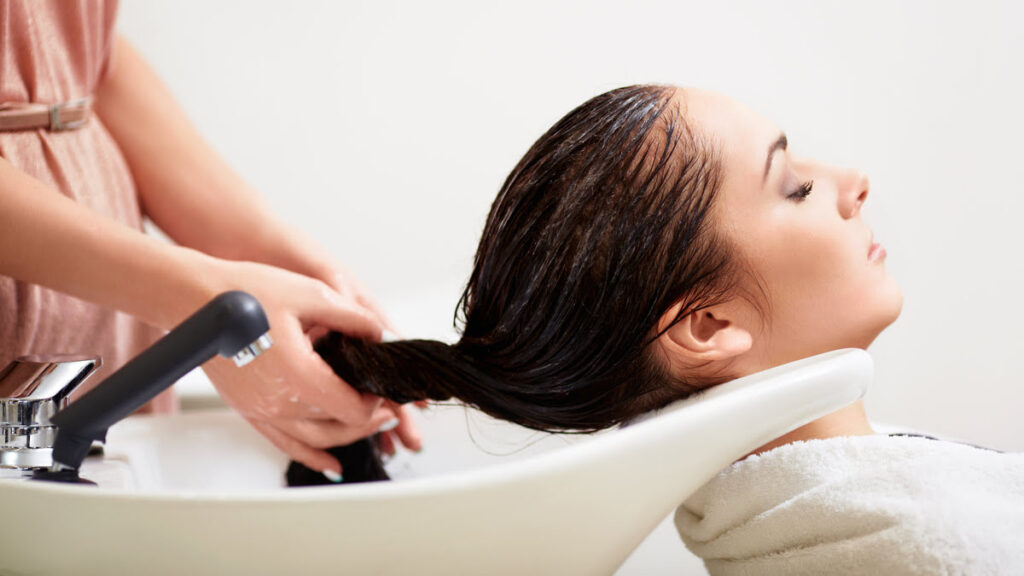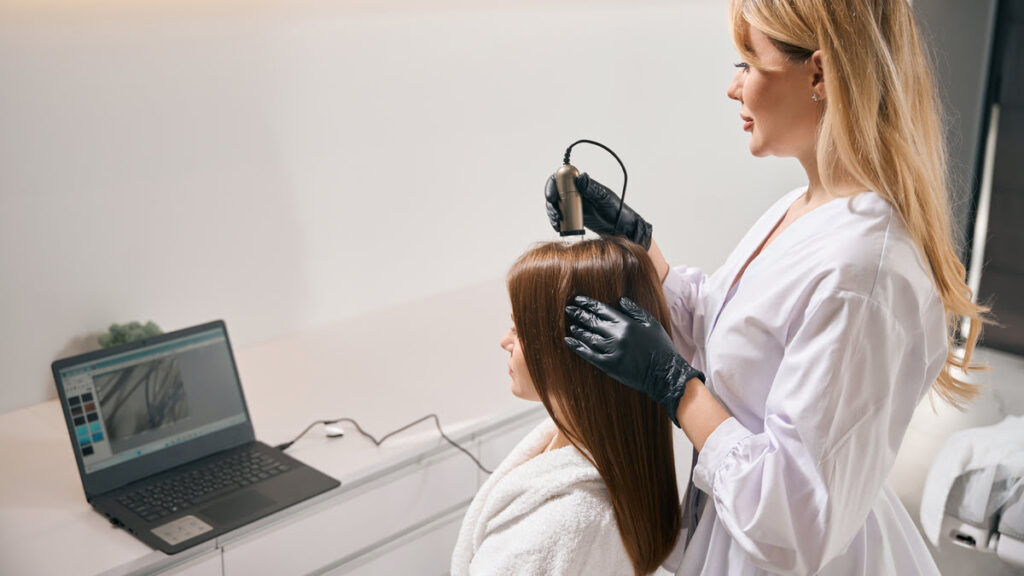
Who among us does not dream of beautiful, smooth and shiny hair? Daily styling, weather conditions and chemical treatments unfortunately make our strands lose their natural elasticity, become dull and prone to damage. Luckily, there is an effective way to regenerate them – hair lamination, which helps restore their healthy appearance, softness and silky smoothness. This treatment can be done both at the hairdresser’s and at home, using readily available ingredients, including gelatin.
What is hair lamination?
Hair lamination is a hair care treatment that aims to improve the appearance and overall condition of hair.
The process involves coating strands with a special preparation that forms a protective layer on the surface of the hair to prevent damage and loss of moisture. As a result, strands become smoother, shinier and less susceptible to external factors.
For best results, the hair must be properly prepared. The first step is to wash them thoroughly to remove the remains of styling products and any impurities. Next, a laminating substance is applied – this can be, for example, gelatin or a ready-made cosmetic designed for this type of treatment. The selected preparation should be evenly distributed over the entire length of the hair, so that each strand is thoroughly covered with it.
In order for the active ingredients to penetrate the hair structure, an additional heat source is used – usually the strands are wrapped in foil and a towel or a special cap is applied. After a certain period of time, the product is rinsed off, and the hair gains silky softness, elasticity and natural shine. Regular laminating also helps protect strands from breakage, smooths their structure and makes them look healthier and more cared for.
Hair lamination in a hair salon
Professional hair lamination is a procedure performed in hair salons, the effects of which can last up to three months. In Poland, its cost usually ranges from PLN 300 to 800, and the final result is influenced by both the technology applied and the preparations used. Hair salons use keratin for laminating, which effectively smooths hair, making it more flexible, stronger and full of shine.
Keratin is a natural protein that builds hair structure, which is used in professional treatments to regenerate and smooth strands. Interestingly, gelatin, although mainly associated with food products, has a similar effect – it forms a protective layer on the surface of the hair, which closes the scales, prevents moisture loss and improves the condition of the hair.

Although salon hair lamination provides long-lasting results, the procedure can also be done at home, using readily available and inexpensive ingredients. That’s why more and more people are choosing to laminate their hair with gelatin, achieving comparable results – smoother, shinier and healthier strands that are less prone to frizz or damage.
Professional hair lamination vs. keratin treatment
Both hair lamination and keratin treatment are designed to improve the condition of strands by closing their scales, rebuilding their structure and strengthening their resistance to damage. Both treatments lead to smooth, healthy-looking hair, but their final results differ.
- Lamination is a treatment that smooths and shines hair, making them more flexible, moisturized and less prone to frizz. It’s great for those who want to improve the appearance of their strands, but still maintain their natural curl or volume.
- Keratin treatment, on the other hand, is a method whose main goal is to permanently straighten hair. It involves the deep insertion of keratin into the hair structure using very high temperatures. This process makes the strands completely smooth, straight and more resistant to humidity.
If the goal is only to regenerate and protect the hair, it is worth opting for lamination. On the other hand, if the priority is to achieve a glass hair effect, keratin treatment is a better choice for flawless, disciplined strands.
When is it a good idea to opt for hair lamination?
Laminating is a treatment recommended in particular for medium and highly porous hair, that is, hair that absorbs a lot of moisture, takes a long time to dry and is easily frizzy.
Laminating is also worth opting for if your hair:
- are prone to frizz and difficult to style,
- are easily tangled, rough and dull,
- have been weakened by frequent bleaching or styling at high temperatures,
- tend to be wavy or curly, and lack bounce,
- are very straight, but lack luster and volume,
- are difficult to tame.
Simply put, lamination is a great solution for anyone who wants to enjoy smooth, nourished and less frizz-prone strands without having to turn to heavy-duty styling products.
How to determine the hair porosity before lamination?
Hair porosity is the degree of opening of the hair’s scales, which affects its appearance, susceptibility to styling and ability to absorb moisture. Three main types of porosity can be distinguished – low, medium and high. Knowing them allows you to choose the right care and determine whether laminating will be an effective solution for your hair type.
- Low-porous hair – is characterized by tightly adhering scales, making it naturally smooth, shiny and resistant to frizz. However, their structure makes it difficult for them to absorb nutrients, and inappropriate cosmetics can easily weigh them down, causing a limp effect.
- Medium-porous hair – is the most common type. Their scales are moderately open, which means that with proper care they can maintain a balance between shine and volume. They tend to be wavy and are sometimes prone to frizz when exposed to humid air.
- Highly-porous hair – their scales are maximally open, so they easily absorb moisture, but just as quickly lose it. They are often dull, rough and weakened, and their structure requires intensive regeneration. This category often includes curly hair, heavily bleached or damaged by heat styling.
How to determine hair porosity?

In addition to visual assessment, there are several methods that help determine hair porosity:
- Water test – simply place a single hair in a glass of water and observe how it behaves. Low-porous hair floats to the surface, medium-porous hair submerges halfway, and high-porous hair sinks to the bottom, absorbing water like a sponge.
- Diagnostic questionnaires – tests available online help determine porosity based on questions about how hair behaves under different conditions.
- Trichological examination – the most precise method, involving analysis of hair structure under a microscope by a specialist.
Knowing the porosity of your hair allows you to make informed care choices and assess whether laminating will give you the desired results. Medium- and high-porosity hair usually benefit the most from this treatment, while with low-porosity hair, you need to be careful not to weigh it down.
Hair lamination at home
Hair lamination is a procedure that can be performed not only in a hair salon, but also at home, using readily available food ingredients. Gelatin, flaxseed, jelly or even potato flour will work great for this purpose. Home lamination is a simple and quick way to smooth, shine and regenerate hair, and its biggest advantage is its low cost – the necessary ingredients can be bought for just a few pennies.
However, it should be remembered that the effects of home lamination last for a shorter time than a salon treatment – usually up to 2-3 washes. To maintain the effect of shiny and smooth strands, the procedure is recommended to be repeated regularly.
Hair lamination with gelatin
Gelatin is one of the most commonly used home solutions for lamination. It forms a protective film on the hair, which smooths strands, adds shine and reduces frizz. The right combination of gelatin and emollients will ensure healthy-looking and bouncy hair.
Ingredients:
- 3 tablespoons of hot water,
- 1 tablespoon of gelatin,
- 1 tbsp of emollient mask or conditioner (preferably containing argan oil, macadamia oil, avocado oil, milk proteins or keratin).
How to do hair lamination with gelatin?
- Dissolve gelatin in hot water and mix thoroughly until you get a uniform, lump-free consistency.
- Add conditioner or mask and mix again.
- Wash your hair with shampoo and dry it with a towel so that it is damp, but not wet.
- Evenly apply the prepared mixture to your hair – from 1/4 of the length to the ends.
- Put a foil cap or cling film over your hair and wrap your head in a towel to create a warming layer.
- Leave on for about 30 minutes, then rinse thoroughly with lukewarm water.
Result? Smoother, shinier and more frizz-resistant hair after just the first use!
Hair lamination with jelly
Jelly is an interesting alternative to gelatin – it contains humectants (sugar) and proteins that help smooth hair and make it easier to comb.
How to do hair lamination with jelly?
- Pour 2 tablespoons of jelly over 3-4 tablespoons of hot water, stir until it reaches a gel-like consistency.
- Spread the slightly cooled mixture on washed and dried hair.
- Put on a foil cap and towel for 15-20 minutes, then rinse.
- Apply an emollient mask for another 15-20 minutes.
- Rinse thoroughly and apply silicone oil for extra protection.
After the treatment, the hair not only becomes silky smooth and shiny, but also smells fruity!
Hair lamination with potato flour
Potato flour is a natural source of starch that smooths strands and adds shine.
How to do hair lamination with potato flour?
- Mix a teaspoon of potato flour with 2 tablespoons of smoothing hair mask.
- Apply the concoction to washed and damp hair, avoiding the scalp.
- Leave on for 20 minutes, then rinse thoroughly.
This treatment makes hair shiny and less prone to static.

Hair lamination with flaxseed
Flaxseed is a rich source of fatty acids, protein, zinc and antioxidants that nourish hair, strengthen it and close its scales.
How to do hair lamination with flaxseed?
- Boil 3 tablespoons of flaxseed in 500 ml of water until you get a gel consistency.
- Pour the whole thing through a sieve to remove the seeds, and set aside to cool.
- Mix the resulting gel with an emollient mask and apply to damp hair.
- Wrap your head with foil and a towel, leave it for 30 minutes, and then rinse thoroughly.
The result is smooth, supple and well-moisturized hair, less prone to frizz and split ends.
Hair lamination at home | FAQ
At-home hair lamination is a simple way to give your strands smoothness, shine and protection from frizz. However, to get the best results, it’s worth knowing the answers to the most frequently asked questions about this treatment. Is hair lamination healthy? How often should it be done? Which ingredient – gelatin, jelly or flaxseed – will work best? In this section, we dispel your doubts and give you tips on how to best care for your hair when laminating at home.
Laminating hair with gelatin or flaxseed?
Choosing the right laminating treatment depends on your hair type and individual needs. Flaxseed is a great option for those who tend to overload their hair with protein. It contains omega-3 fatty acids, which nourish and protect the strands, as well as forming a protective layer that helps to close the scales. It is particularly recommended for curly and colour-treated hair as it adds bounce and moisture.
Gelatin lamination, on the other hand, will work well for those whose hair responds well to proteins, especially keratin. Gelatin has a smoothing effect, tightens the strands and gives them a healthy shine. However, care should be taken with the frequency of the treatment, as too much can lead to dry and stiff hair.
Laminating hair with gelatin or jelly?
Gelatin provides hair with pure proteins that strengthen strands and give them a healthy appearance. It is a good option for those who want to add texture, shine and smoothness to their hair.
Jelly, on the other hand, in addition to gelatin, also contains sugar (a humectant) and citric acid, which closes the hair’s scales and has a chelating effect. This type of lamination therefore moisturises and smoothens the hair at the same time. It works especially well on low-porous hair that tends to stick together.
Hair lamination at home or in a hair salon?
Professional lamination performed in a salon is often based on the application of keratin, which not only smooths but also regenerates the strands. The effects of such a treatment can last up to several months, but the cost ranges from PLN 300 to 800.
At-home hair lamination, although less permanent, is a much cheaper alternative. The effects last up to a few washes, but the treatment can be repeated regularly to enjoy shiny, smooth hair without the need to visit the hairdresser.
Is hair lamination healthy?
Yes, laminating is a safe and beneficial treatment, especially for hair subjected to heat, styling or dryness. It creates a protective layer that protects strands from mechanical damage, prevents tangling and smooths their structure. The result is more resilient, bouncy and shiny hair.
Is there a vegan alternative to gelatin lamination?
Yes, those looking for plant-based laminating methods can turn to agar, a natural gelatin substitute extracted from red seaweed. Agar has a moisturising effect as it contains polysaccharides that help retain moisture in the hair. Importantly, the agar laminating treatment is performed in exactly the same way as gelatin treatment.
How often do I perform gelatin hair lamination?
The frequency of treatment depends on the porosity and condition of the hair. In the case of highly porous or severely damaged hair, an excess of protein can lead to protein overload, i.e. dryness and stiffness. To avoid this, gelatin lamination should be done no more often than every 14 days.
For those with medium- to low-porous hair that tolerates protein well, laminating can be used more frequently, but it is always worth observing the hair’s reaction and adjusting the frequency of treatments according to the individual’s needs.



